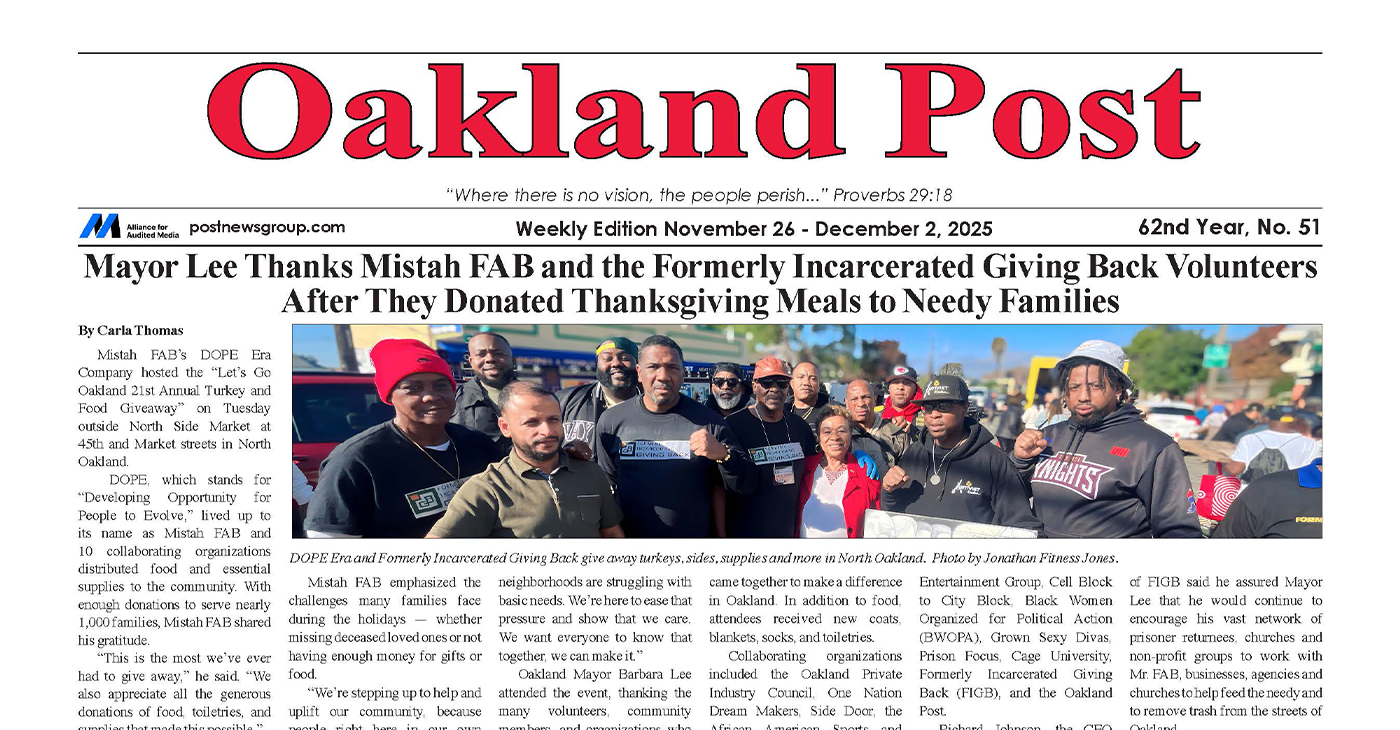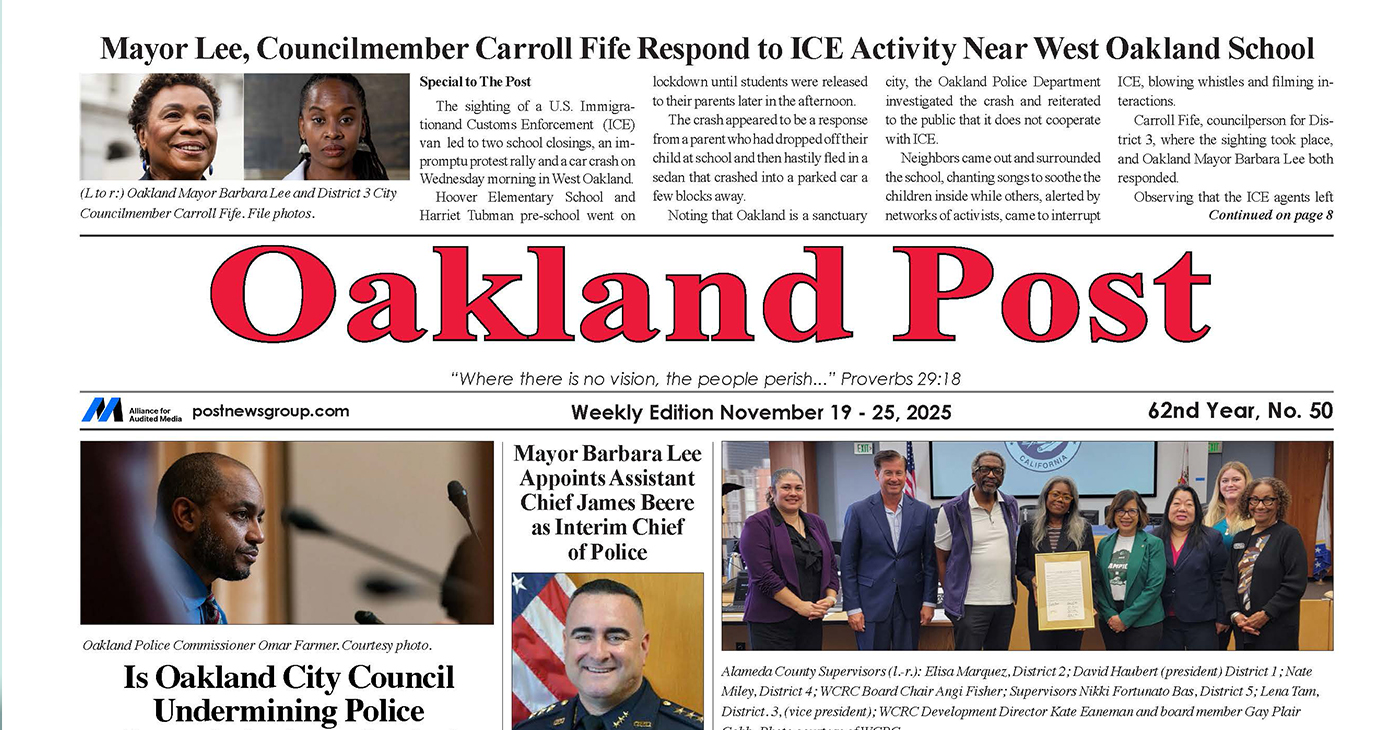Bay Area
CEO of Oakland A’s Addresses Community Concerns
Oakland A’s CEO Dave Kaval said he understands that the A’s parallel process of courting two cities simultaneously appears disingenuous to the public. “We’ve been in Oakland for 55 years and we want to stay here but we must be realistic. We’re spending $2 million a month to keep this project going and we’re running out of time, and still have not got approval. The League is putting pressure on us, our lease is through in 2024, and these projects take time. We hope something comes to fruition and we have a resolution this summer.”

Oakland Ballpark Project Part 3
By Tanya Dennis
Oakland A’s President David Kaval was surprised to learn that concerns expressed by the original designers of the Howard Terminal had all but been ignored by city and business leaders who are pressing to build a new stadium and housing at the site and has vowed to investigate.
Amid the flurry of lawsuits, protests and community concerns regarding the City of Oakland and Oakland A’s stadium project at the Port of Oakland, the most worrisome issue was posed by Frederick Jordan, CEO of FEJA, the engineers that designed the Howard Terminal.
According to Jordan, the Environmental Impact Report reveals what he described as a lack of information regarding safety with the quay wall that supports Howard Terminal, where the largest cranes in North America operate. The terminal also provides a turning basin for ships as large as high-rise buildings.
Kaval wonders why there has been no response to Jordan’s concerns, despite the fact that Jordan reaching out to the City, the A’s and the Port last year.
“It is problematic to me that Jordan was never contacted, and I don’t have an answer why he wasn’t, but I’ll investigate,” Kaval said. “The U.S. Army Corp of Engineers are making an assessment, and one of the key concessions on the table is 10 acres of land to be set aside to accommodate these large container ships.”
When informed of Kaval’s response, Jordan expressed relief. “I feel assured knowing the U.S. Army Corp of Engineers is making an assessment, as they cannot be bought nor influenced.”
Kaval also indicated that the SSA terminals and the Old America Seaport at the Oakland Army Base can be utilized for the larger containers. Also, 30 acres of the outer Port area will be dedicated for the same purpose so that the community concerns on the project negatively impacting Chinatown, Fruitvale and the Lower Bottoms are addressed.
“Trucks are currently going through the neighborhood to get to Howard Terminal,” Kaval said. “Enforcement of established truck staging areas that are not in people’s neighborhoods must occur, and the ballpark project is going to force the Port and the City to build those areas out, which probably won’t happen if this project doesn’t go forward.
“We’ve worked closely with the City for four years to address the concerns of the public because the last thing we want is to repeat the mistakes of past sports entities in Oakland when they left the City,” Kaval said.
Another important concern for Kaval is race and equity-based jobs and opportunities. “We’ve worked with the city to establish critical criteria to address internal staffing at the A’s to assure diversity, small business support and minority hiring. Our baseline report addressed the glaring need of countering gentrification and displacement, with $50 million going towards displacement, money to help local homeowners renovate their homes, including 35% of housing construction for low-income citizens. Our mix of grants and loans will help keep people in their homes and retain the cultural relevance of the neighborhood.”
Kaval indicated that despite opponents’ concerns of gentrification, he believes it will happen naturally if not for the money this project will generate to retain the existing culture. “Good-paying jobs will help people maintain and stay in their homes.”
Kaval said he understands that the A’s parallel process of courting two cities simultaneously appears disingenuous to the public. “We’ve been in Oakland for 55 years and we want to stay here but we must be realistic. We’re spending $2 million a month to keep this project going and we’re running out of time, and still have not got approval. The League is putting pressure on us, our lease is through in 2024, and these projects take time. We hope something comes to fruition and we have a resolution this summer.”
Alameda County
Seth Curry Makes Impressive Debut with the Golden State Warriors
Seth looked comfortable in his new uniform, seamlessly fitting into the Warriors’ offensive and defensive system. He finished the night with an impressive 14 points, becoming one of the team’s top scorers for the game. Seth’s points came in a variety of ways – floaters, spot-up three-pointers, mid-range jumpers, and a handful of aggressive drives that kept the Oklahoma City Thunder defense on its heels.

By Y’Anad Burrell
Tuesday night was anything but ordinary for fans in San Francisco as Seth Curry made his highly anticipated debut as a new member of the Golden State Warriors. Seth didn’t disappoint, delivering a performance that not only showcased his scoring ability but also demonstrated his added value to the team.
At 35, the 12-year NBA veteran on Monday signed a contract to play with the Warriors for the rest of the season.
Seth looked comfortable in his new uniform, seamlessly fitting into the Warriors’ offensive and defensive system. He finished the night with an impressive 14 points, becoming one of the team’s top scorers for the game. Seth’s points came in a variety of ways – floaters, spot-up three-pointers, mid-range jumpers, and a handful of aggressive drives that kept the Oklahoma City Thunder defense on its heels.
One of the most memorable moments of the evening came before Seth even scored his first points. As he checked into the game, the Chase Center erupted into applause, with fans rising to their feet to give the newest Warrior a standing ovation.
The crowd’s reaction was a testament not only to Seth’s reputation as a sharpshooter but also to the excitement he brings to the Warriors. It was clear that fans quickly embraced Seth as one of their own, eager to see what he could bring to the team’s championship aspirations.
Warriors’ superstar Steph Curry – Seth’s brother – did not play due to an injury. One could only imagine what it would be like if the Curry brothers were on the court together. Magic in the making.
Seth’s debut proved to be a turning point for the Warriors. Not only did he contribute on the scoreboard, but he also brought a sense of confidence and composure to the floor.
While their loss last night, OKC 124 – GSW 112, Seth’s impact was a game-changer and there’s more yet to come. Beyond statistics, it was clear that Seth’s presence elevated the team’s performance, giving the Warriors a new force as they look to make a deep playoff run.
Activism
Oakland Post: Week of November 26 – December 2, 2025
The printed Weekly Edition of the Oakland Post: Week of November 26 – December 2, 2025

To enlarge your view of this issue, use the slider, magnifying glass icon or full page icon in the lower right corner of the browser window.
Activism
Oakland Post: Week of November 19 – 25, 2025
The printed Weekly Edition of the Oakland Post: Week of November 19 – 25, 2025

To enlarge your view of this issue, use the slider, magnifying glass icon or full page icon in the lower right corner of the browser window.
-

 Activism3 weeks ago
Activism3 weeks agoOakland Post: Week of November 12 – 18, 2025
-

 Activism2 weeks ago
Activism2 weeks agoIN MEMORIAM: William ‘Bill’ Patterson, 94
-

 Activism3 weeks ago
Activism3 weeks agoHow Charles R. Drew University Navigated More Than $20 Million in Fed Cuts – Still Prioritizing Students and Community Health
-

 Bay Area3 weeks ago
Bay Area3 weeks agoNo Justice in the Justice System
-

 #NNPA BlackPress3 weeks ago
#NNPA BlackPress3 weeks agoThe Perfumed Hand of Hypocrisy: Trump Hosted Former Terror Suspect While America Condemns a Muslim Mayor
-

 #NNPA BlackPress2 weeks ago
#NNPA BlackPress2 weeks agoTrump’s Death Threat Rhetoric Sends Nation into Crisis
-

 #NNPA BlackPress4 weeks ago
#NNPA BlackPress4 weeks agoProtecting Pedophiles: The GOP’s Warped Crusade Against Its Own Lies
-

 #NNPA BlackPress2 weeks ago
#NNPA BlackPress2 weeks agoLewis Hamilton set to start LAST in Saturday Night’s Las Vegas Grand Prix


























































